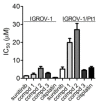Efficacy of a Selective Binder of αVβ3 Integrin Linked to the Tyrosine Kinase Inhibitor Sunitinib in Ovarian Carcinoma Preclinical Models
- PMID: 31013908
- PMCID: PMC6521192
- DOI: 10.3390/cancers11040531
Efficacy of a Selective Binder of αVβ3 Integrin Linked to the Tyrosine Kinase Inhibitor Sunitinib in Ovarian Carcinoma Preclinical Models
Abstract
Ovarian carcinoma, the most lethal gynecological cancer, is characterized by late diagnosis, with drug resistance limiting the efficacy of platinum-based therapy. Since some integrins are upregulated in cancer, including ovarian carcinoma, they represent a potential target for drug delivery. Receptor tyrosine kinases are also deregulated in cancer and their expression has been associated with drug resistance. Here, the antitumor effects of three conjugates possessing a selective binder of the extracellular portion of integrin αVβ3 covalently linked to the tyrosine kinase inhibitor sunitinib were investigated in cisplatin-sensitive and -resistant ovarian carcinoma cells expressing both tyrosine kinase VEGFR2 and αVβ3 at different levels. We found that one of the three compounds was active in inhibiting the growth of both drug-sensitive and -resistant cells in the micromolar range with a slightly increased potency in resistant cells as compared to sunitinib. The same compound markedly impaired cell migratory and invasive abilities and reduced paxillin phosphorylation. Antitumor activity studies in IGROV-1/Pt1 cells xenografted in nude mice revealed a striking activity of this conjugate versus sunitinib. Taken together, our results support the interest of integrin-targeted sunitinib conjugates for the treatment of drug-resistant tumors.
Keywords: RGD ligands; RTK inhibitors; integrins; molecular conjugates; ovarian carcinoma; sunitinib.
Conflict of interest statement
The authors declare no conflict of interest.
Figures







Similar articles
-
Cell-targeted c(AmpRGD)-sunitinib molecular conjugates impair tumor growth of melanoma.Cancer Lett. 2019 Apr 1;446:25-37. doi: 10.1016/j.canlet.2018.12.021. Epub 2019 Jan 11. Cancer Lett. 2019. PMID: 30639534
-
Receptor tyrosine kinase inhibitor Sunitinib and integrin antagonist peptide HM-3 show similar lipid raft dependent biphasic regulation of tumor angiogenesis and metastasis.J Exp Clin Cancer Res. 2019 Aug 28;38(1):381. doi: 10.1186/s13046-019-1324-7. J Exp Clin Cancer Res. 2019. Retraction in: J Exp Clin Cancer Res. 2020 Feb 17;39(1):35. doi: 10.1186/s13046-020-1538-8. PMID: 31462260 Free PMC article. Retracted.
-
Integrin-targeted AmpRGD sunitinib liposomes as integrated antiangiogenic tools.Nanomedicine. 2019 Jun;18:135-145. doi: 10.1016/j.nano.2019.02.015. Epub 2019 Mar 6. Nanomedicine. 2019. PMID: 30849548
-
Sunitinib: from rational design to clinical efficacy.J Clin Oncol. 2007 Mar 1;25(7):884-96. doi: 10.1200/JCO.2006.06.3602. J Clin Oncol. 2007. PMID: 17327610 Review.
-
Sunitinib: a multitargeted receptor tyrosine kinase inhibitor in the era of molecular cancer therapies.BioDrugs. 2009;23(6):377-89. doi: 10.2165/11318860-000000000-00000. BioDrugs. 2009. PMID: 19894779 Review.
Cited by
-
Cell adhesion in cancer: Beyond the migration of single cells.J Biol Chem. 2020 Feb 21;295(8):2495-2505. doi: 10.1074/jbc.REV119.007759. Epub 2020 Jan 14. J Biol Chem. 2020. PMID: 31937589 Free PMC article. Review.
-
Cyclic pentapeptide cRGDfK enhances the inhibitory effect of sunitinib on TGF-β1-induced epithelial-to-mesenchymal transition in human non-small cell lung cancer cells.PLoS One. 2020 Aug 18;15(8):e0232917. doi: 10.1371/journal.pone.0232917. eCollection 2020. PLoS One. 2020. PMID: 32810161 Free PMC article.
-
Revisiting chemoresistance in ovarian cancer: Mechanism, biomarkers, and precision medicine.Genes Dis. 2020 Dec 1;9(3):668-681. doi: 10.1016/j.gendis.2020.11.017. eCollection 2022 May. Genes Dis. 2020. PMID: 35782973 Free PMC article. Review.
-
Molecular Delivery of Cytotoxic Agents via Integrin Activation.Cancers (Basel). 2021 Jan 15;13(2):299. doi: 10.3390/cancers13020299. Cancers (Basel). 2021. PMID: 33467465 Free PMC article. Review.
-
What Is the Fuss about Integrins and the Tumor Microenvironment?Cancers (Basel). 2019 Sep 3;11(9):1296. doi: 10.3390/cancers11091296. Cancers (Basel). 2019. PMID: 31484335 Free PMC article.

